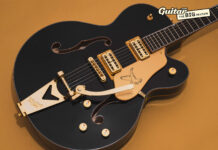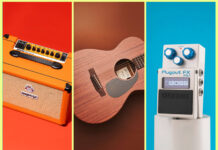
Why earplugs matter and a guide to getting a pair of your own
What do family heirloom guitars, that tattered t-shirt you’ve kept from the first concert you ever went to, and your ears all have in common? They’re ear-replaceable (get it? Ear-replaceable? See what we did there?). In this article, we will be looking at the best ways to protect those two treasures on the sides of your head whether you are a concertgoer, musician, or just really into your hearing.
Lisa Tannenbaum, an audiologist who has been working with musicians for 25 years says, “Unlike sound equipment and instruments that can be repaired or replaced, you only get one set of ears. Once damaged, you can’t tweak, fix or replace them. Despite the fact that ears are, arguably, the most valuable tools musicians possess, they are too often neglected or taken for granted.”
In recent years, there has been increasing discussion around hearing conservation and reduction of ear injury. Innovations in technology have not only made hearing protection more widely accessible, but education has shown us how much control we have in the longevity of our hearing. We give you this article in the spirit of jamming passionately into your triple digits, with all those precious hair cells still intact.
What happens if you just don’t wanna?
You love your music loud. You wanna rock ’n’ roll all night. We get it, we get it. But chew on this for a second: noise-induced ear damage is completely, 100 per cent preventable.
Tannenbaum mentions, “Many musicians either don’t consider the value of their ears, or aren’t motivated to protect them until they notice a problem. And hearing loss is just one of the risks involved in (neglecting ear-protection).”
She goes on to list ringing in ears (tinnitus), increased sensitivity to ordinary sound/reduced loudness tolerance (Hyperacusis), sound distortion (Dysacusis), and abnormal shift in pitch perception between ears (Diplacusis) as some of the side effects of noise-induced hearing damage.
Image: Getty ImagesConsidering the impact some of these side effects can have on your daily life, hearing protection may be one of the best investments you make both for your career and your overall future. And remember, you don’t need to be a performer to benefit from a good set of earplugs during a live performance. Concertgoers, sound engineers, stage crew, and security guards can all benefit from a good set of well-fitting earplugs with the right amount of sound suppression.
Custom vs. O.T.C.
If you can afford custom plugs then stop reading this article, and get on it. Not only can you depend on them for protection, but they will make your listening experience all the more enjoyable. While there are a number of choices, the industry standard are the ER (Etymotic Research – the people who pioneered the original design and idea) custom plugs.
The number that comes after the ER (9, 15, or 25) represents how much sound reduction you will get. This reduction is made possible through an interchangeable plastic button with a filter in it that pops into the plug. The idea is that by following the curve of natural canal resonance of most ears, you will get a flat frequency response. In other words, everything sounds pretty close to how it would with plugs, but just a little quieter.
An added bonus? Custom plugs can actually help you hear conversation better while attending a live event. For all you singers out there, this can help a lot with vocal strain after attending a concert and needing to repeat yourself five times to the friend you came with.
“hearing protection may be one of the best investments you make both for your career and your overall future”
While custom earplugs are undeniably the more luxurious choice, the most important thing is to protect yourself. If you don’t have the money to splurge on custom plugs, look for ER20 high-fidelity O.T.C. plugs. They aren’t remotely as reliable as custom plugs, but for $15 a pop they share the flat-frequency response concept and can help keep you safe. If you’re really in a pinch, foam plugs will do. Just be sure that you don’t scooch them out to hear better (they can make things sound muffled and distorted), because then you aren’t only defeating the purpose but you also look like a nerd.
While we’d love to say that anything is better than nothing… it’s not. We’ve heard all sorts of stories about wadded up cocktail napkins getting stuck, toilet paper gone astray and other well-intentioned mishaps. Stick with the tried and true methods we’ve discussed above.
Picking the right audiologist
The next step is to get your ears moulded. It’s important to work with an audiologist with the proper expertise and training and who will make deep ear impressions. It is also preferable to find an audiologist who has extensive experience working with music industry clients.
A good audiologist will help you choose which filters are best for you, encourage you to have a baseline hearing test and guide you through some safe listening tips. While the process is generally safe and painless, it does require sticking a piece of foam or cotton so deep inside your ear that you can feel your brain cry, so you want to be sure you go to somebody who knows what they are doing.
An ideal impression ensures that the earplug will give you a proper seal for peak protection and an ideal audiologist will follow through with you to make sure the plugs fit comfortably. This part is key because you are a hell of a lot less likely to wear your earplugs if they are rubbing you (literally) the wrong way.
Image: Getty ImagesNuts & bolts
While there are many companies manufacturing custom earplugs, we put our trust in those who work with the original specifications established by Etymotic Research. This will ensure an accurate frequency response, reliable protection, and comfort. We recommend the Sensaphonics ER plugs which use the same medical-grade silicon that they use for their in-ear monitors. It doesn’t harden or shrink with time the way vinyl and other materials do. They also run every plug through a mass meter to be certain every product meets ER specs.
We also recommend getting a designated pouch or holder for your plugs. Earplugs are comically easy to lose and their partialness to nightlife doesn’t help their case. Do as we say, not as we do, and please… do not shove your custom earplugs into the back pocket of your jeans – your washing machine doesn’t need the extra protection. Trust us. We tried it so you don’t have to.
Another thing to consider is if you want a choice in colour. The standard is clear with clear filters, but you can get them in a gamut of colours including fan favourites like neon-swirls and purple glitter. We are also a big fan of mixing and matching: hot pink on the right, silver on the left. Very posh. An added bonus here is that bright colours make them easier to find in dark places.
Those bold colours are a nice option to have, particularly if you want to get out there and make a statement about your commitment to hearing protection.
We think you should.
For more features, click here.
The post Why earplugs matter and a guide to getting a pair of your own appeared first on Guitar.com | All Things Guitar.
Source: www.guitar-bass.net











